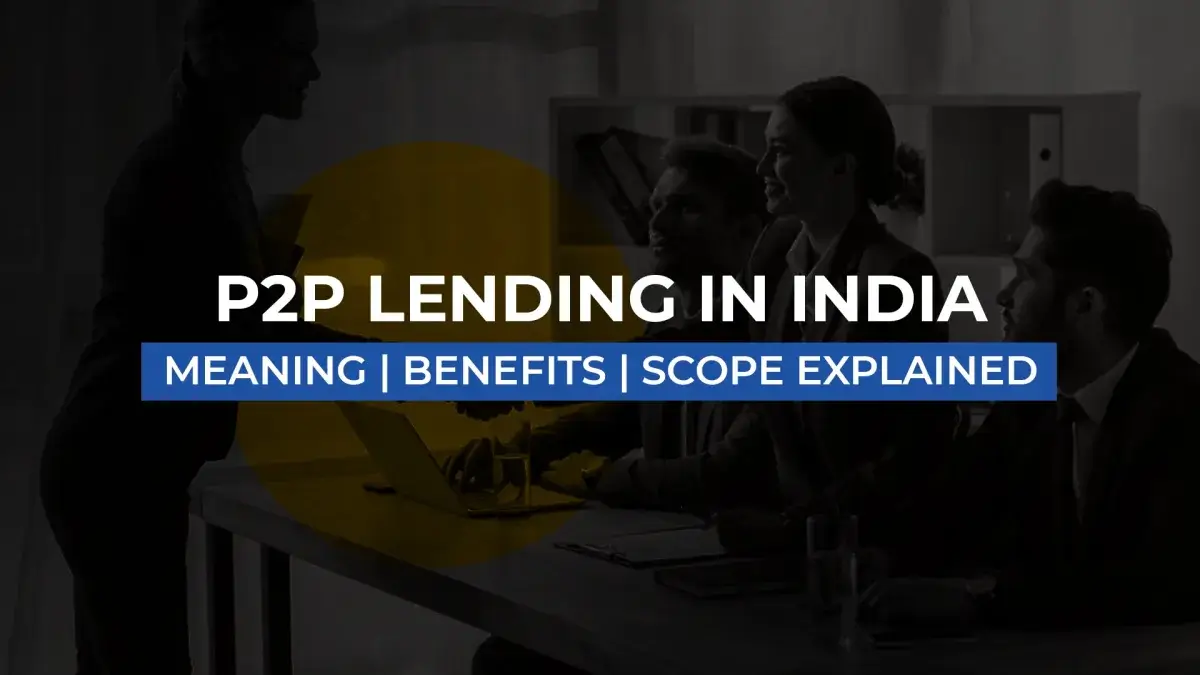P2P Lending in India – Meaning, Benefits, Scope Explained

Here's What We've Covered!
We are aware that technology is changing the face of Indian banking. However, what’s more fascinating is that technology has gone ahead of the realms of banking. When we talk of loans what’s the first thing that comes to our mind? A bank, right? But not anymore. The entire business of borrowing and lending is not just limited to banks. Enter P2P lending or Peer-to-Peer lending wherein you directly borrow or lend your money from/to people who match your requirements.
P2P or Peer to Peer lending is nothing but a digital marketplace for loans. Here a borrower can directly approach an individual who is willing to lend him money at a pre-determined rate. The profile of the borrower is displayed on the portal so that the lender, who is actually an investor, can ascertain his creditworthiness and decide whether to lend him money.
What are the benefits of P2P lending?
India has quite warmed up to the idea of P2P lending and it has immense benefits to say the least. Some of its leading benefits are:
To the lenders:
Instead of keeping their money in savings banks, people would want to earn more returns. For those who like to take up that extra bit of risk, P2P lending offers an opportunity to earn higher returns through more interest.
To the borrowers:
- There are cases, when someone has a good financial credibility but is unable to get a loan from bank due to various reasons. For example, the person may have become self-employed after being terminated from a job or quitting it. Most banks will not prefer to lend to such people, but P2P lending has come to their rescue.
- P2P lending is most preferred by early stage start-ups who do not consider seeking funding from banks as a feasible idea. Banks usually demand a higher rate of interest and a collateral, which is difficult for entrepreneurs to furnish. In such cases, alternative financing avenues like P2P lending is a huge relief.
What are the risks involved in P2P lending?
Since, P2P is in its nascent stages, it has its fair share of risks as well. Banks conduct a thorough background screening of the borrower and due diligence before lending, hence they hedge themselves well against the risks. However, in P2P lending, the investors decide to lend money based on their perception of the borrower. Also, the borrower also faces some limitations and security issues as compared to that of the bank. Some of the evident drawbacks of P2P lending are:
- The amount of loan availed is lower than that of bank
- There is lack of uniform rules of lending and it varies from lender to lender.
- Mismatch in the number of lenders and borrowers. Most of the times the borrowers outnumber the lenders.
- Risk of loss of money in case of default
- Lack of regulation and protection for frauds or monetary crimes.
Current status of P2P lending in India
P2P lending is legal in India and in August 2017, the Reserve Bank of India has classified all the Peer to peer lending sites under Non-Banking Financial Companies (NBFC). Currently, the P2P lending space in India has more than 30 players which includes Faircent, i2iFunding, LenDenClub, LendBox, Monexo, IndiaMoneyMart, Rupaiya Exchange, LoanBaba, CapZest, and many others.
P2P lending has been in India since 2014, but it gained momentum in 2016-17 due to the slowdown in the lending by most banks. The pricing of the loans is based on the risk quotient. For example: For a default rate of 2%, the lending rate will be somewhere around 12% to 15%, while for a default rate at 9% to 10%, the lending rate will be as high as 30% to 35%.
Opportunity for P2P lending in days to come
As we mentioned earlier, P2P lending in India is yet to develop. As per the current regulations, the P2P NBFCs cannot lend for a duration of more than 36 months. Hence, the trend and report on defaults can be assessed only after one cycle post RBI regulations is completed. This would take another 2 years.
The RBI has also put stringent regulations on the loanable funds at Rs 10 lakhs. Also there is no such attraction as guaranteed returns which can mislead investors. This will also promote healthy competition. In a nutshell, the RBI has placed all the controls in right places. Therefore it remains to be seen how things pan out in the next few years.
Many investors are game about the idea of lending their excess funds to credible borrowers and reap high interests. For slightly established portals, the risk of default is also taken care of. The P2P NBFCs undertake legal action against the defaulted borrowers. They charge a fixed sum as fees out of the recovered amount.
However, the future of P2P lending looks bright in India. Experts estimate that the P2P lending industry is all set to touch $5 billion by 2023. Many P2P lenders are also actively seeking membership of credit bureaus to perform credit assessment of borrowers and also report the performance of the borrower.
Resent Post
>
Emerging commerce career options in India (2026): From CA to Data Analyst
>
ACCA Opportunities You Didn’t Know About – Think Beyond Audit!
>
Which Courses After 12th Commerce With High Salary Are in Demand Worldwide?
>
How to Find ACCA Jobs Online After Qualifying: Real Portals, Tips & Career Guidance
>
Financial Modelling Classes in Hyderabad: Your Guide to the Best Institutes
Follow Us For All Updates!



